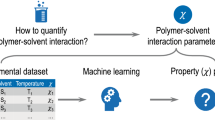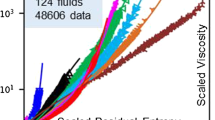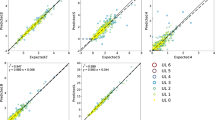Abstract
In this study, we present a new model that has been developed for the prediction of θ (lower critical solution temperature) using a database of 169 data points that include 12 polymers and 67 solvents. For the characterization of polymer and solvent molecules, a number of molecular descriptors (topological, physicochemical, steric and electronic) were examined. The best subset of descriptors was selected using the elimination selection-stepwise regression method. Multiple linear regression (MLR) served as the statistical tool to explore the potential correlation among the molecular descriptors and the experimental data. The prediction accuracy of the MLR model was tested using the leave-one-out cross-validation procedure, validation through an external test set and the Y-randomization evaluation technique. The domain of applicability was finally determined to identify the reliable predictions.





Similar content being viewed by others
References
(a) Charlet G, Delmas G (1981) Polymer 22:1181–1189; (b) Charlet G, Ducasse R, Delmas G (1981) Polymer 22:1190–1198
Christensen SP, Donate FA, Frank TC, LaTulip RJ, Wilson LC (2005) J Chem Eng Data 50:869–877
Kavanagh CA, Rochev YA, Gallagher WM, Dawson KA, Keenan AK (2004) Pharmacol Ther 102:1–15
Kopecek J (2003) Eur J Pharm Sci 20:1–16
Chang BH, Bae CY (1998) Polymer 39:6449–6454
Pappa GD, Voutsas EC, Tassios DP (2001) Ind Eng Chem Res 40:4654–4663
Bogdanic G, Vidal J (2000) Fluid Phase Equilib 173:241–252
Wang F, Saeki S, Yamaguchi T (1999) Polymer 40:2779–2785
Vetere A (1998) Ind Eng Chem Res 37:4463–4469
Imre AR, Bae YC, Chang BH, Kraska Th (2004) Ind Eng Chem Res 43:237–242
Liu H, Zhong C (2005) Eur Polym J 41:139–147
Liu H, Zhong C (2005) Ind Eng Chem Res 44:634–638
Melagraki G, Afantitis A, Sarimveis H, Igglessi-Markopoulou O, Supuran CT (2006) Bioorg Med Chem 14:1108–1114
Afantitis A, Melagraki G, Sarimveis H, Koutentis PA, Markopoulos J, Igglessi-Markopoulou O (2005) Mol Divers (In press) DOI: 10.1007/s11030-005-9012-2
Afantitis A, Melagraki G, Makridima K, Alexandridis A, Sarimveis H, Igglessi-Markopoulou O (2005) J Mol Struct Theochem 716:193–198
Melagraki G, Afantitis A, Makridima K, Sarimveis H, Igglessi-Markopoulou O (2005) J Mol Model 12:297–305
Al-Fahemi JH, Cooper DL, Allan NL (2005) J Mol Struct Theochem 727:57–61
Villanueva-Garcıa M, Gutierrez-Parra RN, Martınez-Richa A, Robles J (2005) J Mol Struct Theochem 727:63–69
CambridgeSoft Corporation (http://www.cambridgesoft.com)
Efron B (1983) J Am Stat Assoc 78:316–331
Efroymson MA (1960) Multiple regression analysis. In: Ralston A, Wilf HS (eds) Mathematical methods for digital computers. Wiley, New York, pp 191–203
Osten DW (1998) J Chemom 2:39–48
Wold S, Eriksson L (1995) Statistical validation of QSAR results. In: van de Waterbeemd H (ed) Chemometrics methods in molecular design. VCH, Weinheim, pp 309–318
Tropsha A, Gramatica P, Gombar VK (2003) Quant Struct-Act Relatsh 22:1–9
Golbraikh A, Tropsha A (2002) J Mol Graph Model 20:269–276
Shen M, Beguin C, Golbraikh A, Stables J, Kohn H, Tropsha A (2004) J Med Chem 47:2356–2364
Atkinson A (1985) Plots, transformations and regression. Clarendon, Oxford, p 282
Acknowledgements
G.M. wishes to thank the Greek State Scholarship Foundation for a doctoral assistantship. A.A. wishes to thank Cyprus Research Promotion Foundation (grant no. PENEK/ENISX/0603/05) and A.G. Leventis Foundation for their financial support.
Author information
Authors and Affiliations
Corresponding author
Rights and permissions
About this article
Cite this article
Melagraki, G., Afantitis, A., Sarimveis, H. et al. A novel QSPR model for predicting θ (lower critical solution temperature) in polymer solutions using molecular descriptors. J Mol Model 13, 55–64 (2007). https://doi.org/10.1007/s00894-006-0125-z
Received:
Accepted:
Published:
Issue Date:
DOI: https://doi.org/10.1007/s00894-006-0125-z




